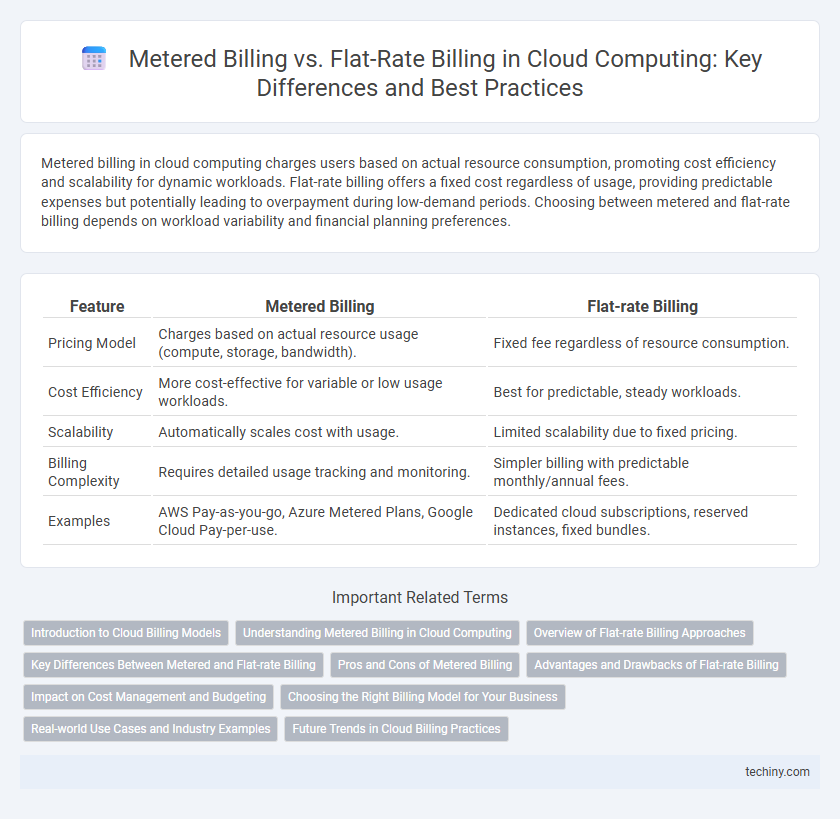Metered billing in cloud computing charges users based on actual resource consumption, promoting cost efficiency and scalability for dynamic workloads. Flat-rate billing offers a fixed cost regardless of usage, providing predictable expenses but potentially leading to overpayment during low-demand periods. Choosing between metered and flat-rate billing depends on workload variability and financial planning preferences.
Table of Comparison
| Feature | Metered Billing | Flat-rate Billing |
|---|---|---|
| Pricing Model | Charges based on actual resource usage (compute, storage, bandwidth). | Fixed fee regardless of resource consumption. |
| Cost Efficiency | More cost-effective for variable or low usage workloads. | Best for predictable, steady workloads. |
| Scalability | Automatically scales cost with usage. | Limited scalability due to fixed pricing. |
| Billing Complexity | Requires detailed usage tracking and monitoring. | Simpler billing with predictable monthly/annual fees. |
| Examples | AWS Pay-as-you-go, Azure Metered Plans, Google Cloud Pay-per-use. | Dedicated cloud subscriptions, reserved instances, fixed bundles. |
Introduction to Cloud Billing Models
Metered billing charges customers based on actual resource consumption, providing flexibility and cost efficiency for dynamic workloads. Flat-rate billing offers a fixed fee regardless of usage, simplifying budgeting and billing processes for predictable workloads. Cloud providers often support both models to accommodate diverse business needs and optimize operational expenses.
Understanding Metered Billing in Cloud Computing
Metered billing in cloud computing charges customers based on actual resource consumption, such as CPU usage, storage, or bandwidth, providing cost transparency and flexibility. This model enables enterprises to optimize expenses by paying only for what they use, supporting dynamic workloads and scaling needs. Cloud providers like AWS, Azure, and Google Cloud offer metered billing to ensure precise cost allocation aligned with real-time usage patterns.
Overview of Flat-rate Billing Approaches
Flat-rate billing in cloud computing involves charging customers a fixed fee for predetermined resource usage, providing predictable costs and simplifying budgeting. This approach often applies to subscription plans where users pay a consistent monthly or annual rate regardless of actual consumption. Flat-rate models are suitable for businesses with stable or predictable workloads, minimizing billing complexity and enabling easier cost management.
Key Differences Between Metered and Flat-rate Billing
Metered billing in cloud computing charges customers based on actual resource usage, providing granular cost control and flexibility for fluctuating workloads. Flat-rate billing offers a fixed monthly or annual fee regardless of consumption, simplifying budgeting but potentially leading to overpayment during low usage periods. Key differences include cost predictability, scalability, and alignment with usage patterns, where metered billing suits dynamic environments and flat-rate benefits consistent, predictable workloads.
Pros and Cons of Metered Billing
Metered billing in cloud computing offers precise cost allocation by charging users based on actual resource consumption, promoting cost efficiency and scalability for dynamic workloads. This model can lead to unpredictable monthly expenses, complicating budgeting and financial planning for businesses with fluctuating usage patterns. Metered billing also demands robust monitoring systems to track consumption accurately, potentially increasing operational complexity and administrative overhead.
Advantages and Drawbacks of Flat-rate Billing
Flat-rate billing offers predictable monthly costs, simplifying budgeting for cloud computing services by charging a fixed fee regardless of usage volume. This billing model can lead to cost savings for organizations with consistent or heavy resource consumption but may result in overpayment during periods of low usage. However, flat-rate billing lacks the flexibility to scale expenses in alignment with fluctuating resource demands, potentially causing inefficiencies compared to metered billing models.
Impact on Cost Management and Budgeting
Metered billing in cloud computing offers precise cost management by charging based on actual resource usage, enabling organizations to align expenses directly with consumption and avoid overspending. Flat-rate billing provides predictable monthly costs, simplifying budgeting but may lead to overpayment if usage is below the allocated threshold or unexpected expenses if usage exceeds the flat rate. Choosing between metered and flat-rate billing significantly impacts financial planning strategies, with metered billing favoring variable workloads and flat-rate billing benefiting steady, predictable cloud consumption.
Choosing the Right Billing Model for Your Business
Choosing the right billing model for cloud computing depends on your business's usage patterns and cost predictability needs. Metered billing offers scalability by charging based on actual resource consumption, ideal for variable workloads and startups seeking cost efficiency. In contrast, flat-rate billing provides fixed monthly costs, benefiting businesses with steady usage that prioritize budgeting stability.
Real-world Use Cases and Industry Examples
Metered billing in cloud computing offers precise cost allocation based on actual resource consumption, enabling startups and SaaS companies like Netflix and Dropbox to scale efficiently without overpaying during low-demand periods. Flat-rate billing suits enterprises with predictable workloads, such as financial institutions and healthcare providers, offering budget stability and simplified expense management. Hybrid models are also common in industries like e-commerce, where fluctuating traffic demands metered billing while baseline operations rely on flat-rate plans for cost control.
Future Trends in Cloud Billing Practices
Future trends in cloud billing practices indicate a shift toward more granular metered billing models, leveraging real-time data analytics and AI to optimize cost transparency and resource usage. Flat-rate billing remains relevant for predictable workloads but is increasingly supplemented by hybrid approaches that combine fixed fees with usage-based charges. Cloud providers are adopting advanced pricing algorithms and dynamic billing strategies to enhance flexibility and customer satisfaction in evolving market demands.
Metered Billing vs Flat-rate Billing Infographic

 techiny.com
techiny.com